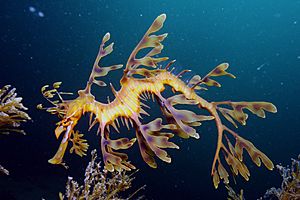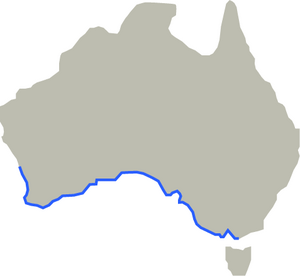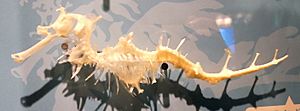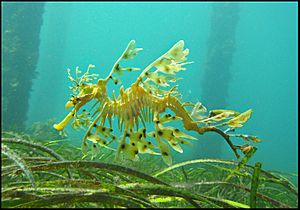Leafy seadragon facts for kids
Quick facts for kids Leafy seadragon |
|
|---|---|
 |
|
| Conservation status | |
| Scientific classification | |
| Genus: |
Phycodurus
|
| Species: |
eques
|
 |
|
| Phycodurus eques range | |
| Synonyms | |
|
|
The leafy seadragon (Phycodurus eques) is a special type of fish that lives in the ocean. It is also sometimes called Glauert's seadragon. This amazing creature belongs to the same family as seahorses and pipefish. It is the only species in its group, called Phycodurus.
You can find leafy seadragons along the southern and western coasts of Australia. They get their name from the long, leaf-like parts that stick out all over their bodies. These "leaves" are not used for swimming. Instead, they help the seadragon hide by looking like floating seaweed.
Leafy seadragons swim using tiny, clear fins. One fin is on their neck, and another is on their back near the tail. These fins are so small and clear that they are hard to see. They wave gently, making the seadragon look like it's just drifting in the water.
People often call them "leafies." The leafy seadragon is a symbol for the state of South Australia. It is also a very important animal for marine conservation efforts there.
Contents
About the Leafy Seadragon
Just like a seahorse, the leafy seadragon's name comes from what it looks like. It reminds people of a mythical dragon. While they are not huge, leafy seadragons are a bit bigger than most seahorses. They can grow to be about 20 to 24 centimeters (8 to 9.5 inches) long.
Leafy seadragons eat tiny ocean creatures. Their diet includes plankton and small crustaceans.
Amazing Camouflage
The leafy parts on the seadragon's skin are perfect for camouflage. They make the seadragon look exactly like a piece of seaweed. When it swims, it moves slowly, keeping the illusion that it's just floating.
Leafy seadragons can also change their color to blend in even better. How well they can change color depends on what they eat, how old they are, where they live, and if they are feeling stressed.
Family Connections
The leafy seadragon is related to the pipefish and is part of the Syngnathidae family, just like seahorses. However, it looks different from a seahorse. It also moves differently and cannot curl its tail to grab onto things.
A close relative is the weedy seadragon. Weedy seadragons have many colors and weed-like fins, but they are smaller than leafy seadragons. Another unique thing about leafy seadragons is their small, round gill openings. Most fish have crescent-shaped gill openings.
Where Leafy Seadragons Live
Leafy seadragons are found only in the waters of southern Australia. Their home range stretches from Wilson’s Promontory in Victoria all the way west to Jurien Bay in Western Australia. Jurien Bay is about 220 kilometers (137 miles) north of Perth.
Scientists used to think that individual seadragons stayed in very small areas. But new research shows they can travel hundreds of meters from their usual spots. They use a strong sense of direction to find their way back home.
You can usually find them in waters up to 50 meters (164 feet) deep. They like sandy areas near rocks covered in kelp and clumps of sea grass. Scuba divers often see them near Adelaide in South Australia. Popular spots include Rapid Bay, Edithburgh, and Victor Harbor.
Leafy Seadragon Life
Leafy seadragons usually live alone. When it's time to breed, the males will try to attract females. Then, a male and female will pair up. Once baby seadragons hatch, they are completely on their own. By the time they are two years old, they are usually fully grown and ready to have their own babies.
What They Eat
Leafy seadragons eat by sucking up small crustaceans. These include tiny amphipods and mysid shrimp. They also eat plankton and very small larval fish. They use their long, pipe-like snout to suck up their food.
Reproduction and Life Cycle
Like seahorses, the male leafy seadragon is the one who takes care of the eggs. The female produces up to 250 bright pink eggs. She then places them onto the male's tail using a long tube called an ovipositor.
The eggs stick to a special patch on the male's tail. This patch gives the eggs oxygen. After about nine weeks, the eggs start to hatch. The exact time depends on the water conditions. During this time, the eggs change color to a deep purple or orange.
The male helps the babies hatch by pumping his tail. He also rubs his tail against seaweed and rocks. This process can take 24 to 48 hours. Once born, the young seadragon is completely independent. They eat small zooplankton until they are big enough to hunt mysids. Only about 5% of the eggs survive to hatch.
When they first hatch, baby seadragons have a small yolk sac attached to them. This sac gives them food for the first few days. This means they can go off and hunt right away. The yolk sac is like a safety net for the newborns.
How They Move
Leafy seadragons use the fins on the sides of their heads to steer and turn. However, their outer skin is quite stiff, which makes it hard for them to move quickly.
Sometimes, individual leafy seadragons stay in one place for a long time, even up to 68 hours. But they can also move for long periods. One seadragon was tracked moving at a speed of up to 150 meters (492 feet) per hour.
Protecting Leafy Seadragons
Leafy seadragons face many dangers, both from nature and from people. They are sometimes caught by collectors. They are also used in some alternative medicine practices. When they are first born, they are very vulnerable. They are also slow swimmers, which makes it hard for them to escape from predators.
After big storms, seadragons are often washed onto the shore. This is because, unlike seahorses, they cannot curl their tails to hold onto seagrasses and stay safe.
The species has become endangered because of pollution and chemicals from industries. Collecting them for aquariums has also been a problem. Because of these dangers, leafy seadragons are now fully protected by law. They have been protected in South Australia since 1987, in Victoria since at least 1995, and in Western Australia since 1991.
Also, the Australian Government has listed the species under the Environment Protection and Biodiversity Conservation Act 1999. This means that any new building projects must consider the well-being of the leafy seadragon.
Seeing Leafy Seadragons in Aquariums
It is very hard and expensive to get leafy seadragons for private aquariums. This is because they are protected by law. Any seadragons must come from special captive bred programs. Exporters need to prove that their breeding seadragons were caught legally before the protection laws started.
Leafy seadragons are also very difficult to keep alive in aquariums. Only large public aquariums usually have the money and knowledge to care for them properly. So far, attempts to breed leafy seadragons in captivity have not been successful.
Where to See Them
If you want to see a leafy seadragon, you can visit several public aquariums around the world:
- Australia: You can see them at the Sydney Aquarium, the Melbourne Aquarium, and the Aquarium of Western Australia.
- Canada: Ripley's Aquarium of Canada in Toronto has both leafy and weedy seadragons.
- South East Asia: The South East Asia Aquarium in Singapore displays both leafy and weedy seadragons.
- United States: Many aquariums in the U.S. have leafy seadragon displays. These include the Adventure Aquarium in New Jersey, Aquarium of the Pacific in California, the Birch Aquarium in San Diego, the Minnesota Zoo, the Monterey Bay Aquarium in California, the Dallas World Aquarium in Texas, the New England Aquarium in Boston, the Point Defiance Zoo & Aquarium in Washington, the Shedd Aquarium in Chicago, the California Academy of Sciences, the Tennessee Aquarium, SeaWorld Orlando in Florida, the Pittsburgh Zoo & PPG Aquarium, Ripley's Aquarium of the Smokies in Tennessee, The Florida Aquarium in Florida, and Ripley's Aquarium Broadway at the Beach in South Carolina.
Images for kids
See also
 In Spanish: Dragón de mar foliado para niños
In Spanish: Dragón de mar foliado para niños





